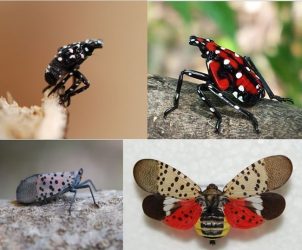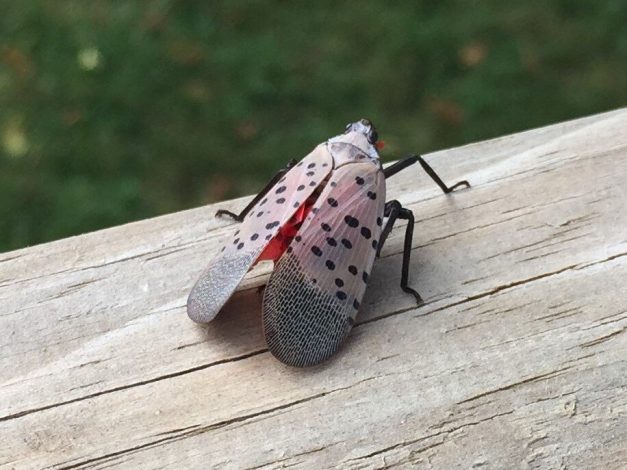Maybe you are familiar with the Emerald Ash Borer or the Asian Longhorned Beetle, but do you know about the Spotted Lanternfly? It is an emerging invasive insect that, if left unchecked, will wreak havoc on farms, orchards, and gardens in the Tristate area, including our lovely Teatown. It’s already causing sleepless nights for everyone from environmentalists to farmers to loggers.
What is Spotted lanternfly and why is it so bad?
The Spotted Lanternfly is a nuisance pest native to Asia, first identified in Pennsylvania in 2014. It has since spread through eastern Pennsylvania into Delaware, Maryland, New Jersey, and now, the lower Hudson valley. A dead specimen was found in Croton Point Park within the last year.
It uses piercing, sucking mouthparts to feed on over 70 different plants and trees, including hardwoods of the timber industry and farm and orchard crops such as apples, grapes, peaches, hops, and walnuts. Simply, it poses an unprecedented threat to agriculture and our natural resources. Left untreated, Spotted Lanternfly could decimate farms and forests, costing hundreds of millions of dollars and hundreds of thousands of jobs in affected industries.
What does it look like?
Fully grown, Spotted Lanternfly looks like a mix between a huge moth and a ladybug. It is strikingly beautiful (for an insect) with brightly colored red and brown wings spotted with black dots. They are about one inch long and half an inch wide with their wings closed. They generally fly and hop low to the ground and, because of their bright colors, are hard to miss.
Depending on the time of year, however, the Spotted Lanternfly may look different. This is because it has distinct growth stages. Nymphs begin to hatch from eggs in May. In their first three nymph stages, they are mostly black with white spots and no wings. Late-stage nymphs develop the distinguishing scarlet color and typically appear in July. They then molt into adults in mid- to late summer.

Spotted Lanternfly is a hitchhiker and a leaf jumper. Though it has wings, it doesn’t fly. It has made its way throughout the Mid-Atlantic by hitching rides on vehicles or laying eggs on wood pallets. This gives hope that it can be contained if identified, which is why we need your help.
Signs of spotted lanternfly
Spotted lanternflies feed on trees and excrete a sugary sappy substance called “honeydew.” A black fungus called “sooty mold” will then grow on the honeydew. Look at the base of maple, walnut, and tree of heaven (aka Ailanthus) for this black fungus.
Spotted lanternfly also causes serious plant damage, including oozing sap, wilting, leaf curling and dieback in trees, vines, crops, and many other types of plants. Look for plants that ooze or weep and have a fermented odor.
During late summer and fall, females lay eggs in rows and cover them in a waxy secretion that is white when freshly laid and brownish gray when dry. It looks like cement and will remain on trees, plants, outdoor sheds, and patio furniture from October through April.

What to do if you spot one
This pest should not be taken lightly. If you see one, kill it immediately and report your sighting to the NY State Agriculture and Markets department with this public reporting portal here, as well as on nyiMapinvasives.org.
Knowledgeable residents are our best defense against this ruthless invader. It takes a full effort from everyone to save our farms, forests, and even your own backyard.

ABOUT THE AUTHOR
Kevin Sterne
Kevin Sterne is Teatown’s Preserve Technician and Facilities Maintainer. He’s a writer, artist, and advocate for trees through his organization Savethecedars.org. You can often find him walking his dog Kodi on the trails and saying hi to the trees.




Leave a Reply